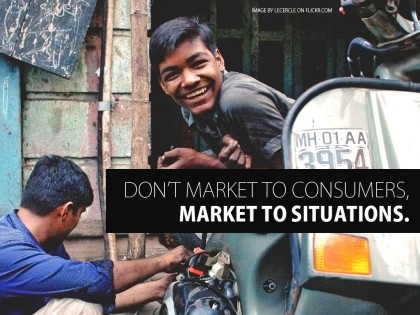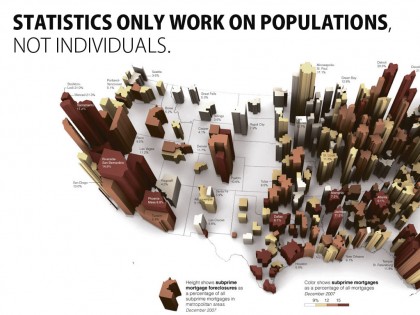In the more services / utility based advertising and marketing landscape we need to start focusing our marketing on activities not individuals, on tasks and situations not demographics.

In the regard that customers are incomprehensibly complex and incredibly expensive to map out with a degree of quality, if at all possible, we need to shift our targeting towards a more secure and qualitative framework.
By changing the focus from the customer to the activity we want our customer to perform, we can ignore the irrationality and non-existing structured homogeneity of humans
. This lets us identify incentives and desires based on what we want to achieve, not on a set of fictional people, based on non-defining stereotypes like age or income, who we think are more likely to buy our products. Statistics only work on populations, not individuals.

Well, situations are the answer.
Advertising is not about awareness, it’s about getting the customer or participant to complete a task – you need to want them to do something, not just look at you. Present day formats are to limited by the cost of media placement and the lack of use of cooperative platforms to fix this mess. Therefore it becomes even more imminent to focus on a richer set of channels for advertising, and then the Situation Based Marketing becomes important.
The concept is kind of reverse engineering. You identify and profile your task, and then start working with a range of subjects in order to understand it. As compared to trying to understand a limited set of participants in order to identify a segment more likely to complete the task, ignore it all and find the incentives and drivers for the task – exclusively
.
In other words, situation is key, the reason being many:
- – Removes the focus from irrational humans and focuses on the task they are about to perform. This increases the ability to understand their goal – in this context and work with their incentives and desires.
– Humans are irrational, situations highly comprehensible
with the patient and have the patient actively participating cialis their ED..
.
– The goal of the communication becomes much more obvious and less expensive to understand.
– Ignores demographics, which in itself avoids a whole range of misunderstandings, individual interpretations and “stereotypical” errors
.
– The brand is only visible to participants in the relevant context. When customers are doing something else the brand is most likely non-existent. The need therefore to map out a whole individual for the purpose of ONE small activity is a waste of resources and removes clarity from the report at the end of the research.
This methodology is in essence an extension of the UX-mindset put forward by amongst others Indi Young and Robert Hoekman
. But pulling it all the way into other forms of marketing seems to provide a range of gains regarding clarity, focus and knowledge.
It’s not for all situations and all forms of marketing, but for those occasions where the situation the marketing will appear in, and where the task we want the communication to lead to is clear, this most certainly opens up some interesting opportunities.


[…] opened up a whole new kind of marketing. I’ve previously called this both content marketing, situation marketing and even activity based advertising. But have after a rummage through my mac dictionary ended up […]
[…] And connecting this idea to the utilities/services mindset; where companies need to explore existing situations and activities in order to discover where and how they can create deliberate value. […]